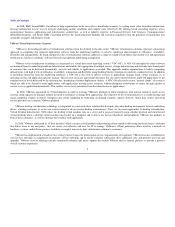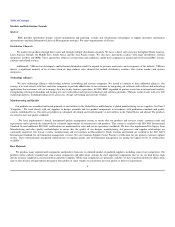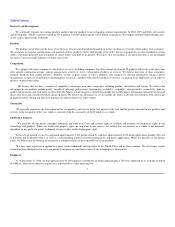EMC 2008 Annual Report Download - page 19
Download and view the complete annual report
Please find page 19 of the 2008 EMC annual report below. You can navigate through the pages in the report by either clicking on the pages listed below, or by using the keyword search tool below to find specific information within the annual report.
Table of Contents
a governing tax authority will not have a different interpretation of the law and assess us with additional taxes. Should we be assessed with additional taxes,
there could be a material adverse effect on our results of operations or financial condition.
Changes in regulations could materially adversely affect us.
Our business, results of operations or financial condition could be materially adversely affected if laws, regulations or standards relating to us or our
products are newly implemented or changed. In addition, our compliance with existing regulations may have a material adverse impact on us. Under
applicable federal securities laws, including the Sarbanes-Oxley Act of 2002, we are required to evaluate and determine the effectiveness of our internal
control structure and procedures for financial reporting. Should we or our independent auditors determine that we have material weaknesses in our internal
controls, our results of operations or financial condition may be materially adversely affected or our stock price may decline.
Changes in generally accepted accounting principles may adversely affect us.
From time to time, the Financial Accounting Standards Board ("FASB") promulgates new accounting principles that could have a material adverse
impact on our results of operations or financial condition. For example, in May 2008, the FASB voted to issue FASB Staff Position ("FSP") APB 14-1, which
changes the accounting treatment for certain convertible securities which include our Notes. See Note A to our Consolidated Financial Statements.
In addition, in 2007, the FASB issued Statement of Financial Accounting Standards No. 141(R) "Business Combinations." The standard, which is
effective commencing in our 2009 fiscal year, will result in significant changes in accounting for acquisitions. Depending upon the number of and magnitude
of acquisitions which we may consummate in 2009, the standard could have a material adverse effect on our business, results of operations or financial
condition.
Our business could be materially adversely affected as a result of the risks associated with acquisitions and investments.
As part of our business strategy, we seek to acquire businesses that offer complementary products, services or technologies. These acquisitions are
accompanied by the risks commonly encountered in an acquisition of a business, which may include, among other things:
the effect of the acquisition on our financial and strategic position and reputation;
the failure of an acquired business to further our strategies;
the failure of the acquisition to result in expected benefits, which may include benefits relating to enhanced revenues, technology, human
resources, cost savings, operating efficiencies and other synergies;
the difficulty and cost of integrating the acquired business, including costs and delays in implementing common systems and procedures and
costs and delays caused by communication difficulties or geographic distances between the two companies' sites;
the assumption of liabilities of the acquired business, including litigation-related liability;
the potential impairment of acquired assets;
the lack of experience in new markets, products or technologies or the initial dependence on unfamiliar supply or distribution partners;
the diversion of our management's attention from other business concerns;
the impairment of relationships with customers or suppliers of the acquired business or our customers or suppliers;
the potential loss of key employees of the acquired company; and
the potential incompatibility of business cultures.
These factors could have a material adverse effect on our business, results of operations or financial condition. To the extent that we issue shares of our
common stock or other rights to purchase our common stock in connection with any future acquisition, existing shareholders may experience dilution.
Additionally, regardless of the form of consideration issued, acquisitions could negatively impact our net income and our earnings per share.
In addition to the risks commonly encountered in the acquisition of a business as described above, we may also experience risks relating to the challenges
and costs of closing a transaction. Further, the risks described above may be exacerbated as a result of managing multiple acquisitions at the same time.
15
•
•
•
•
•
•
•
•
•
•
•
























